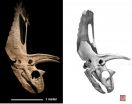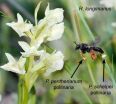(Press-News.org) Bats tend to have a bad reputation. They sleep all day, party at night, and are commonly thought to be riddled with rabies. A study by University of Calgary researchers has confirmed that bats are not as disease-ridden as the stigma suggests.
"The notion that bats have high rates of rabies is not true," says Brandon Klug, a graduate student at the University of Calgary and the lead author of a paper published in the Journal of Wildlife Diseases.
"Those of us that work with bats have always known the rates are low; and now we have evidence that bats aren't disease-ridden vermin their reputation would have you believe."
Previous studies have suggested that typically about 10 per cent of bats taken by the public to be tested have the disease and prevalence varies greatly, depending on the species and how often that species is around people. But University of Calgary research says the number is closer to one per cent regardless of species or where the bats roost.
Researchers compared bats turned in by the general public and those randomly sampled from their natural environment. In the field, they looked for the disease in carcasses of migratory tree-roosting hoary bats (Lasiurus cinereus) and silver-haired bats (Lasionycteris noctivagans) killed by wind turbines. These species are among bat species with the highest reported prevalence of rabies in North America. At the same time they compared these bats with rabies prevalence from literature contained in public health records in North America.
"This study is significant because it confirms that rabies rates for bats has been over-estimated. It's also the first time such a rigorous literature review has been completed on this topic," says co-author Dr. Robert Barclay, biological science professor and head of the Department of Biological Sciences at the University of Calgary.
University of Calgary researchers sent 217 carcasses to the Centers of Disease Control and Prevention in the U.S for testing. They also reviewed the literature on reported rabies in multiple bat species in North America covering the past 56 years, which included 65,096 bats.
Bats, along with other species including foxes, skunks and raccoons, are considered reservoirs for the disease. Rabies is passed from bat to bat at a rate that keeps the virus in the population, but rarely fast enough to eradicate the bat population or slow enough to result in the demise of the virus.
"Since the background rabies rate in bats is low, less than one percent, people should focus more on the ecosystem services they provide without worrying that every other bat has rabies. This is especially important right now because bats are facing some heavy threats, like wind turbines and white nose syndrome," says Klug.
"With that said, healthy bats normally don't come in contact with people, so those that do are more likely to be sick, so we're not encouraging people to go out and handle them."
INFORMATION:
Researchers bust bat rabies stereotype
Rabies rate in bats not as high as estimates suggest
2011-02-01
ELSE PRESS RELEASES FROM THIS DATE:
The science of bike-sharing
2011-02-01
Tel Aviv — The new environmentally-friendly concept of municipal "bike-sharing" is taking over European cities like Paris, and American cities like New York are also looking into the idea. It allows a subscriber to "borrow" a bike from one of hundreds of locations in the city, use it, and return it to another location at the end of the journey. It's good for commuters and for running short errands.
While the idea is gaining speed and subscribers at the 400 locations around the world where it has been implemented, there have been growing pains — partly because the projects ...
Plankton inspires creation of stealth armor for slow-release microscopic drug vehicles
2011-02-01
The ability of some forms of plankton and bacteria to build an extra natural layer of nanoparticle-like armour has inspired chemists at the University of Warwick to devise a startlingly simple way to give drug bearing polymer vesicles (microscopic polymer based sacs of liquid) their own armoured protection.
The Warwick researchers have been able to decorate these hollow structures with a variety of nanoparticles opening a new strategy in the design of vehicles for drug release, for example by giving the vesicle "stealth" capabilities which can avoid the body's defences ...
The changing roles of 2 hemispheres in stroke recovery
2011-02-01
Milan, Italy, 31 January 2010 – Most people who survive a stroke recover some degree of their motor, sensory and cognitive functions over the following months and years. This recovery is commonly believed to reflect a reorganisation of the central nervous system that occurs after brain damage. Now a new study, published in the February 2011 issue of Elsevier's Cortex, sheds further light on the recovery process through its effect on language skills.
For almost all right-handed people and for about 60% of left-handers, damage to the left side of the brain causes a condition ...
Young rats given polyphenols show less endothelial function deterioration with aging
2011-02-01
The endothelium is the inner lining of our blood vessels and normal functions of endothelial cells include enabling coagulation, platelet adhesion and immune function. Endothelial dysfunction is associated with reduced anticoagulant properties and the inability of arteries and arterioles to dilate fully.
The gradual decrease in endothelial function over time is a key factor in the development of diseases associated with ageing, especially cardiovascular disease (CVD). Many epidemiologic studies suggest protection against CVD from moderate intake of alcoholic beverages, ...
Recalled ICD leads fail in women, youths most often
2011-02-01
The recalled Sprint Fidelis implantable cardioverter-defibrillator (ICD) leads (Medtronic) failed more often in younger patients, women, and individuals with hereditary heart disease, according to a multicenter study published online Jan. 17 in Circulation. The researchers found that lead failure was not associated with death or serious injuries.
However, about half of the patients whose leads fractured experienced painful inappropriate shocks, according to lead author Robert G. Hauser, MD, of the Minneapolis Heart Institute® at Abbott Northwestern Hospital. In a previous ...
Scientists find key protein that suppresses prostate cancer growth in the laboratory
2011-02-01
Cancer researchers have discovered an important protein, produced naturally inside cells, that appears to suppress the growth of prostate cancer cells in the laboratory. The findings, published tomorrow in the journal Cancer Research, offer promising leads for research towards new treatments.
Prostate cancer is the most common cancer among men in the UK, with 37,500 men diagnosed with the disease every year. Many prostate cancers are slow growing, but in some cases the cancer is aggressive and spreads to other parts of the body, such as the bone. These cases are much ...
Boys will infect boys, swine flu study shows
2011-02-01
Boys predominantly pass on flu to other boys and girls to girls, according to a new study of how swine flu spread in a primary school during the 2009 pandemic, published today in the journal Proceedings of the National Academy of Sciences. The results also suggest that flu transmission is most intensive between children of the same class, but that sitting next to an infected person does not significantly increase a child's risk of catching flu. The data will help researchers to model how epidemics spread and how interventions such as school closures can help contain an ...
Newly discovered dinosaur likely father of Triceratops
2011-02-01
New Haven, Conn.—Triceratops and Torosaurus have long been considered the kings of the horned dinosaurs. But a new discovery traces the giants' family tree further back in time, when a newly discovered species appears to have reigned long before its more well-known descendants, making it the earliest known member of its family.
The new species, called Titanoceratops after the Greek myth of the Titans, rivaled Triceratops in size, with an estimated weight of nearly 15,000 pounds and a massive eight-foot-long skull.
Titanoceratops, which lived in the American southwest ...
Wealth of orchid varieties is down to busy bees and helpful fungi, says study
2011-02-01
Scientists have discovered why orchids are one of the most successful groups of flowering plants - it is all down to their relationships with the bees that pollinate them and the fungi that nourish them. The study, published tomorrow in the American Naturalist, is the culmination of a ten-year research project in South Africa involving researchers from Imperial College London, the Royal Botanic Gardens, Kew, and other international institutions.
The orchid family is one of the largest groups of flowering plants, with over 22,000 species worldwide. Today's research suggests ...
SRNL demonstrating low-energy remediation with patented microbes
2011-02-01
Using funding provided under the American Reinvestment and Recovery Act, the U.S. Department of Energy's Savannah River National Laboratory has launched a demonstration project near one of the Savannah River Site's former production reactor sites to clean up chemically contaminated groundwater, naturally.
A portion of the subsurface at the Site's P Area has become contaminated with chlorinated volatile organic compounds that are essentially like dry-cleaning fluid. SRNL and Clemson University have patented a consortium of microbes that have an appetite for that kind ...
LAST 30 PRESS RELEASES:
New critique prompts correction of high-profile Yellowstone aspen study, highlighting challenges in measuring ecosystem response to wolf reintroduction
Stroke survivors miss critical treatment, face greater disability due to systemic transfer delays
Delayed stroke care linked to increased disability risk
Long term use of anti-acid drugs may not increase stomach cancer risk
Non-monetary 'honor-based' incentives linked to increased blood donations
Natural ovulation as effective as hormones before IVF embryo transfer
Major clinical trial provides definitive evidence of impacts of steroid treatment on severe brain infection
Low vitamin D levels shown to raise risk of hospitalization with potentially fatal respiratory tract infections by 33%
Diagnoses of major conditions failing to recover since the pandemic
Scientists solve 66 million-year-old mystery of how Earth’s greenhouse age ended
Red light therapy shows promise for protecting football players’ brains
Trees — not grass and other greenery — associated with lower heart disease risk in cities
Chemical Insights scientist receives Achievement Award from the Society of Toxicology
Breakthrough organic crystalline material repairs itself in extreme cold temperatures, unlocking new possibilities for space and deep-sea technologies
Scientists discover novel immune ‘traffic controller’ hijacked by virus
When tropical oceans were oxygen oases
Positive interactions dominate among marine microbes, six-year study reveals
Safeguarding the Winter Olympics-Paralympics against climate change
Most would recommend RSV immunizations for older and pregnant people
Donated blood has a shelf life. A new test tracks how it's aging
Stroke during pregnancy, postpartum associated with more illness, job status later
American Meteorological Society announces new executive director
People with “binge-watching addiction” are more likely to be lonely
Wild potato follows a path to domestication in the American Southwest
General climate advocacy ad campaign received more public engagement compared to more-tailored ad campaign promoting sustainable fashion
Medical LLMs may show real-world potential in identifying individuals with major depressive disorder using WhatsApp voice note recordings
Early translational study supports the role of high-dose inhaled nitric oxide as a potential antimicrobial therapy
AI can predict preemies’ path, Stanford Medicine-led study shows
A wild potato that changed the story of agriculture in the American Southwest
Cancer’s super-enhancers may set the map for DNA breaks and repair: A key clue to why tumors become aggressive and genetically unstable
[Press-News.org] Researchers bust bat rabies stereotypeRabies rate in bats not as high as estimates suggest




